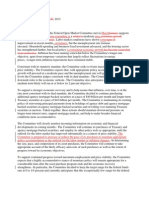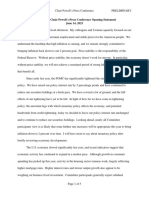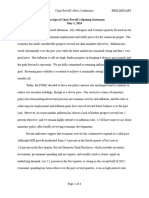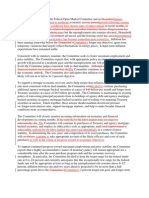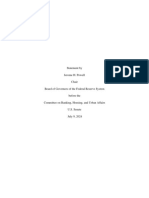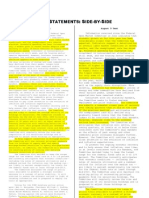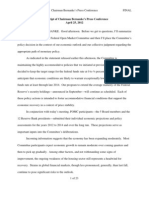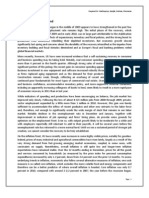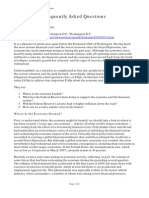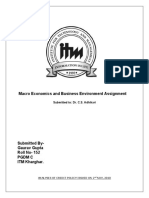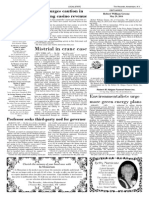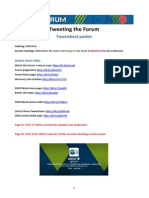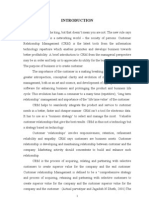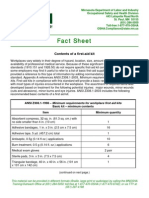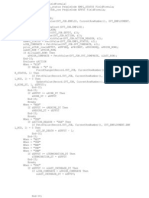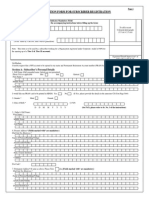0 ratings0% found this document useful (0 votes)
25 viewsSystem
System
Uploaded by
pathanfor7861) The US economy has continued recovering from the 2008 recession, with real GDP growth stepping up to around 3.25% in the second half of 2013.
2) Labor market conditions have improved with unemployment at 6.3% in April 2014, down 1.25 percentage points from a year ago, though levels remain elevated.
3) Inflation has been quite low despite economic expansion, though longer-run inflation expectations have remained stable.
Copyright:
© All Rights Reserved
Available Formats
Download as PDF, TXT or read online from Scribd
System
System
Uploaded by
pathanfor7860 ratings0% found this document useful (0 votes)
25 views8 pages1) The US economy has continued recovering from the 2008 recession, with real GDP growth stepping up to around 3.25% in the second half of 2013.
2) Labor market conditions have improved with unemployment at 6.3% in April 2014, down 1.25 percentage points from a year ago, though levels remain elevated.
3) Inflation has been quite low despite economic expansion, though longer-run inflation expectations have remained stable.
Original Description:
economy
Copyright
© © All Rights Reserved
Available Formats
PDF, TXT or read online from Scribd
Share this document
Did you find this document useful?
Is this content inappropriate?
1) The US economy has continued recovering from the 2008 recession, with real GDP growth stepping up to around 3.25% in the second half of 2013.
2) Labor market conditions have improved with unemployment at 6.3% in April 2014, down 1.25 percentage points from a year ago, though levels remain elevated.
3) Inflation has been quite low despite economic expansion, though longer-run inflation expectations have remained stable.
Copyright:
© All Rights Reserved
Available Formats
Download as PDF, TXT or read online from Scribd
Download as pdf or txt
0 ratings0% found this document useful (0 votes)
25 views8 pagesSystem
System
Uploaded by
pathanfor7861) The US economy has continued recovering from the 2008 recession, with real GDP growth stepping up to around 3.25% in the second half of 2013.
2) Labor market conditions have improved with unemployment at 6.3% in April 2014, down 1.25 percentage points from a year ago, though levels remain elevated.
3) Inflation has been quite low despite economic expansion, though longer-run inflation expectations have remained stable.
Copyright:
© All Rights Reserved
Available Formats
Download as PDF, TXT or read online from Scribd
Download as pdf or txt
You are on page 1of 8
For release on delivery
10:00 a.m. EDT
May 7, 2014
Statement by
J anet L. Yellen
Chair
Board of Governors of the Federal Reserve System
before the
J oint Economic Committee
U.S. Congress
May 7, 2014
Chairman Brady, Vice Chair Klobuchar, and other members of the Committee, I
appreciate this opportunity to discuss the current economic situation and outlook along with
monetary policy before turning to some issues regarding financial stability.
Current Economic Situation and Outlook
The economy has continued to recover from the steep recession of 2008 and 2009. Real
gross domestic product (GDP) growth stepped up to an average annual rate of about
3-1/4 percent over the second half of last year, a faster pace than in the first half and during the
preceding two years. Although real GDP growth is currently estimated to have paused in the
first quarter of this year, I see that pause as mostly reflecting transitory factors, including the
effects of the unusually cold and snowy winter weather. With the harsh winter behind us, many
recent indicators suggest that a rebound in spending and production is already under way, putting
the overall economy on track for solid growth in the current quarter. One cautionary note,
though, is that readings on housing activity--a sector that has been recovering since 2011--have
remained disappointing so far this year and will bear watching.
Conditions in the labor market have continued to improve. The unemployment rate was
6.3 percent in April, about 1-1/4 percentage points below where it was a year ago. Moreover,
gains in payroll employment averaged nearly 200,000 jobs per month over the past year. During
the economic recovery so far, payroll employment has increased by about 8-1/2 million jobs
since its low point, and the unemployment rate has declined about 3-3/4 percentage points since
its peak.
While conditions in the labor market have improved appreciably, they are still far from
satisfactory. Even with recent declines in the unemployment rate, it continues to be elevated.
Moreover, both the share of the labor force that has been unemployed for more than six months
- 2 -
and the number of individuals who work part time but would prefer a full-time job are at
historically high levels. In addition, most measures of labor compensation have been rising
slowly--another signal that a substantial amount of slack remains in the labor market.
Inflation has been quite low even as the economy has continued to expand. Some of the
factors contributing to the softness in inflation over the past year, such as the declines seen in
non-oil import prices, will probably be transitory. Importantly, measures of longer-run inflation
expectations have remained stable. That said, the Federal Open Market Committee (FOMC)
recognizes that inflation persistently below 2 percent--the rate that the Committee judges to be
most consistent with its dual mandate--could pose risks to economic performance, and we are
monitoring inflation developments closely.
Looking ahead, I expect that economic activity will expand at a somewhat faster pace this
year than it did last year, that the unemployment rate will continue to decline gradually, and that
inflation will begin to move up toward 2 percent. A faster rate of economic growth this year
should be supported by reduced restraint from changes in fiscal policy, gains in household net
worth from increases in home prices and equity values, a firming in foreign economic growth,
and further improvements in household and business confidence as the economy continues to
strengthen. Moreover, U.S. financial conditions remain supportive of growth in economic
activity and employment.
As always, considerable uncertainty surrounds this baseline economic outlook. At
present, one prominent risk is that adverse developments abroad, such as heightened geopolitical
tensions or an intensification of financial stresses in emerging market economies, could
undermine confidence in the global economic recovery. Another risk--domestic in origin--is that
- 3 -
the recent flattening out in housing activity could prove more protracted than currently expected
rather than resuming its earlier pace of recovery. Both of these elements of uncertainty will bear
close observation.
Monetary Policy
Turning to monetary policy, the Federal Reserve remains committed to policies designed
to restore labor market conditions and inflation to levels that the Committee judges to be
consistent with its dual mandate. As always, our policy will continue to be guided by the
evolving economic and financial situation, and we will adjust the stance of policy appropriately
to take account of changes in the economic outlook. In light of the considerable degree of slack
that remains in labor markets and the continuation of inflation below the Committees 2 percent
objective, a high degree of monetary accommodation remains warranted.
With the federal funds rate, our traditional policy tool, near zero since late 2008, we have
relied on two less conventional tools to provide support for the economy: asset purchases and
forward guidance. And, because these policy tools are less familiar, we have been especially
attentive in recent years to the need to communicate to the public about how we intend to employ
our policy tools in response to changing economic circumstances.
Our current program of asset purchases began in September 2012 when the economic
recovery had weakened and progress in the labor market had slowed, and we said that our
intention was to continue the program until we saw substantial improvement in the outlook for
the labor market. By December 2013, the Committee judged that the cumulative progress in the
labor market warranted a modest reduction in the pace of asset purchases. At the first three
meetings this year, our assessment was that there was sufficient underlying strength in the
- 4 -
broader economy to support ongoing improvement in labor market conditions, so further
measured reductions in asset purchases were appropriate. I should stress that even as the
Committee reduces the pace of its purchases of longer-term securities, it is still adding to its
holdings, and those sizable holdings continue to put significant downward pressure on longer-
term interest rates, support mortgage markets, and contribute to favorable conditions in broader
financial markets.
Our other important policy tool in recent years has been forward guidance about the
likely path of the federal funds rate as the economic recovery proceeds. Beginning in December
2012, the Committee provided threshold-based guidance that turned importantly on the behavior
of the unemployment rate. As you know, at our March 2014 meeting, with the unemployment
rate nearing the threshold that had been laid out earlier, we undertook a significant review of our
forward guidance. While indicating that the new guidance did not represent a shift in the
FOMCs policy intentions, the Committee laid out a fuller description of the framework that will
guide its policy decisions going forward. Specifically, the new language explains that, as the
economy expands further, the Committee will continue to assess both the realized and expected
progress toward its objectives of maximum employment and 2 percent inflation. In assessing
that progress, we will take into account a wide range of information, including measures of labor
market conditions, indicators of inflation pressures and inflation expectations, and readings on
financial developments. In March and again last month, we stated that we anticipated the current
target range for the federal funds rate would be maintained for a considerable time after the asset
purchase program ends, especially if inflation continues to run below 2 percent, and provided
that inflation expectations remain well anchored. The new language also includes information
- 5 -
on our thinking about the likely path of the policy rate after the Committee decides to begin to
remove policy accommodation. In particular, we anticipate that even after employment and
inflation are near mandate-consistent levels, economic and financial conditions may, for some
time, warrant keeping the target federal funds rate below levels that the Committee views as
normal in the longer run.
Because the evolution of the economy is uncertain, policymakers need to carefully watch
for signs that it is diverging from the baseline outlook and respond in a systematic way to
stabilize the economy. Accordingly, for both our purchases and our forward guidance, we have
tried to communicate as clearly as possible how changes in the economic outlook will affect our
policy stance. In doing so, we will help the public to better understand how the Committee will
respond to unanticipated developments, thereby reducing uncertainty about the course of
unemployment and inflation.
Financial Stability
In addition to our monetary policy responsibilities, the Federal Reserve works to promote
financial stability, focusing on identifying and monitoring vulnerabilities in the financial system
and taking actions to reduce them. In this regard, the Committee recognizes that an extended
period of low interest rates has the potential to induce investors to reach for yield by taking on
increased leverage, duration risk, or credit risk. Some reach-for-yield behavior may be evident,
for example, in the lower-rated corporate debt markets, where issuance of syndicated leveraged
loans and high-yield bonds has continued to expand briskly, spreads have continued to narrow,
and underwriting standards have loosened further. While some financial intermediaries have
- 6 -
increased their exposure to duration and credit risk recently, these increases appear modest to
date--particularly at the largest banks and life insurers.
More generally, valuations for the equity market as a whole and other broad categories of
assets, such as residential real estate, remain within historical norms. In addition, bank holding
companies (BHCs) have improved their liquidity positions and raised capital ratios to levels
significantly higher than prior to the financial crisis. Moreover, recently concluded stress tests
mandated by the Dodd-Frank Act have provided a level of confidence in our assessment of how
financial institutions would fare in an extended period of severely adverse macroeconomic
conditions or a sharp steepening of the yield curve alongside a moderate recession. For the
financial sector more broadly, leverage remains subdued and measures of wholesale short-term
funding continue to be far below levels seen before the financial crisis.
The Federal Reserve has also taken a number of regulatory steps--many in conjunction
with other federal agencies--to continue to improve the resiliency of the financial system. Most
recently, the Federal Reserve finalized a rule implementing section 165 of the Dodd-Frank Act to
establish enhanced prudential standards for large banking firms in the form of risk-based and
leverage capital, liquidity, and risk-management requirements. In addition, the rule requires
large foreign banking organizations to form a U.S. intermediate holding company, and it imposes
enhanced prudential requirements for these intermediate holding companies. Looking forward,
the Federal Reserve is considering whether additional measures are needed to further reduce the
risks associated with large, interconnected financial institutions.
While we have seen substantial improvements in labor market conditions and the overall
economy since the financial crisis and severe recession, we recognize that more must be
- 7 -
accomplished. Many Americans who want a job are still unemployed, inflation continues to run
below the FOMCs longer-run objective, and work remains to further strengthen our financial
system. I will continue to work closely with my colleagues and others to carry out the important
mission that the Congress has given the Federal Reserve.
Thank you. I will be pleased to take your questions.
You might also like
- Subhash Dey's BST XI 2024-25 (Sample PDFDocument58 pagesSubhash Dey's BST XI 2024-25 (Sample PDFEkaspal Singh100% (3)
- A Policy Report: The Case For Investing in Early Grade Reading InterventionsDocument55 pagesA Policy Report: The Case For Investing in Early Grade Reading InterventionsJimmy Graham100% (1)
- Yellen TestimonyDocument7 pagesYellen TestimonyZerohedgeNo ratings yet
- US Fed FOMC Press Conference 18 September 2013 No TaperDocument26 pagesUS Fed FOMC Press Conference 18 September 2013 No TaperJhunjhunwalas Digital Finance & Business Info LibraryNo ratings yet
- Yellen HHDocument7 pagesYellen HHZerohedgeNo ratings yet
- Fomc Pres Conf 20141217Document23 pagesFomc Pres Conf 20141217JoseLastNo ratings yet
- FOMCpresconf 20230503Document25 pagesFOMCpresconf 20230503Edi SaputraNo ratings yet
- Fomc Pres Conf 20160615Document21 pagesFomc Pres Conf 20160615petere056No ratings yet
- Fomc Pres Conf 20130918Document7 pagesFomc Pres Conf 20130918helmuthNo ratings yet
- Fomc Pres Conf 20231101Document26 pagesFomc Pres Conf 20231101Quynh Le Thi NhuNo ratings yet
- Powell 20180717 ADocument6 pagesPowell 20180717 AZerohedgeNo ratings yet
- Oct FOMC RedlineDocument2 pagesOct FOMC RedlineZerohedgeNo ratings yet
- Jerome Powell's Written TestimonyDocument5 pagesJerome Powell's Written TestimonyTim MooreNo ratings yet
- Fed TalkDocument2 pagesFed TalkTelegraphUKNo ratings yet
- Chairman Ben S. BernankeDocument10 pagesChairman Ben S. BernankeZim VicomNo ratings yet
- Bernanke Speech 20110203Document11 pagesBernanke Speech 20110203SarweinNo ratings yet
- FOMC Word For Word Changes. 05.01.13Document2 pagesFOMC Word For Word Changes. 05.01.13Pensford FinancialNo ratings yet
- FOMCpresconf 20230614Document5 pagesFOMCpresconf 20230614Jhony SmithYTNo ratings yet
- Powell 20230621 ADocument5 pagesPowell 20230621 ADaily Caller News FoundationNo ratings yet
- Transcript of Chair Powell's Press Conference Opening Statement March 20, 2024Document4 pagesTranscript of Chair Powell's Press Conference Opening Statement March 20, 2024andre.torresNo ratings yet
- FOMCpresconf 20220615Document27 pagesFOMCpresconf 20220615S CNo ratings yet
- Fomc Pres Conf 20240501Document4 pagesFomc Pres Conf 20240501gustavo.kahilNo ratings yet
- Transcript of Chair Powell's Press Conference May 4, 2022Document24 pagesTranscript of Chair Powell's Press Conference May 4, 2022Learning的生活No ratings yet
- Press Release: For Release at 2:00 P.M. EDTDocument2 pagesPress Release: For Release at 2:00 P.M. EDTTREND_7425No ratings yet
- FOMC Redline MarchDocument2 pagesFOMC Redline MarchZerohedgeNo ratings yet
- FOMCpresconf 20220316Document26 pagesFOMCpresconf 20220316marchmtetNo ratings yet
- Fomc Pres Conf 20241218Document27 pagesFomc Pres Conf 20241218Yoniwo Edward TsemiNo ratings yet
- Fed SideDocument1 pageFed Sideannawitkowski88No ratings yet
- Comptabilité Tle G3 Et G2Document24 pagesComptabilité Tle G3 Et G2albertvalk2.0No ratings yet
- Powell's Prepared StatementDocument4 pagesPowell's Prepared StatementTim MooreNo ratings yet
- FOMCpresconf 20240501Document26 pagesFOMCpresconf 20240501David SimõesNo ratings yet
- Fomc StatmentDocument1 pageFomc Statmentapi-280585983No ratings yet
- Fomc Pres Conf 20220727Document4 pagesFomc Pres Conf 20220727Jessica A. BotelhoNo ratings yet
- PowellDocument4 pagesPowellandre.torres.dinheiramaNo ratings yet
- Fomc Pres Conf 20241107Document22 pagesFomc Pres Conf 20241107sushilaoswal8378No ratings yet
- A New Chapter For The FOMC Monetary Policy FramewDocument2 pagesA New Chapter For The FOMC Monetary Policy FramewsheeginNo ratings yet
- Fed 09212011Document2 pagesFed 09212011andrewbloggerNo ratings yet
- Powell's Stanford Fireside ChatDocument6 pagesPowell's Stanford Fireside ChatTim MooreNo ratings yet
- Fomc Pres Conf 20241107Document23 pagesFomc Pres Conf 20241107Anyaji ChukwudiebubeNo ratings yet
- Federal Reserve Issues FOMC Statement: ShareDocument2 pagesFederal Reserve Issues FOMC Statement: ShareTREND_7425No ratings yet
- Federal Reserve: Unconventional Monetary Policy Options: Marc LabonteDocument37 pagesFederal Reserve: Unconventional Monetary Policy Options: Marc Labonterichardck61No ratings yet
- Transcript of Chairman Bernanke's Press Conference April 25, 2012Document23 pagesTranscript of Chairman Bernanke's Press Conference April 25, 2012CoolidgeLowNo ratings yet
- FOMC Side by Side 11022011Document2 pagesFOMC Side by Side 11022011andrewbloggerNo ratings yet
- Monetary PolicyDocument18 pagesMonetary PolicyAnimNo ratings yet
- Monetary & Fiscal PolicyDocument20 pagesMonetary & Fiscal PolicyMadhupriya DugarNo ratings yet
- FOMC Word For Word Changes 03.20.13Document2 pagesFOMC Word For Word Changes 03.20.13Pensford FinancialNo ratings yet
- FOMC Rate Decision 04.25.12Document1 pageFOMC Rate Decision 04.25.12Pensford FinancialNo ratings yet
- Minutes Feb 2017Document12 pagesMinutes Feb 2017mahajanomicsNo ratings yet
- New Year Speech (2019)Document9 pagesNew Year Speech (2019)hyNo ratings yet
- G20: ST Petersburg Action Plan Sept 2013Document11 pagesG20: ST Petersburg Action Plan Sept 2013slshaw066893No ratings yet
- American: Memorandum (SAMPLE ONLY)Document8 pagesAmerican: Memorandum (SAMPLE ONLY)testtest1No ratings yet
- FOMCpresconf 20221102Document23 pagesFOMCpresconf 20221102Nava PourtaghiNo ratings yet
- ResconfDocument4 pagesResconfgothurded24No ratings yet
- December 17, 2014 Compared With October 29, 2014 Jeremie Cohen-SettonDocument3 pagesDecember 17, 2014 Compared With October 29, 2014 Jeremie Cohen-Settonapi-273992067No ratings yet
- January - March FOMC Statement ComparisonDocument1 pageJanuary - March FOMC Statement Comparisonshawn2207No ratings yet
- Monitory-Policy-Strategy, Case Study - RBADocument9 pagesMonitory-Policy-Strategy, Case Study - RBAoutbox175No ratings yet
- Second Quarter Review of Monetary Policy For 2011-12 Press Statement by Dr. D. Subbarao, GovernorDocument6 pagesSecond Quarter Review of Monetary Policy For 2011-12 Press Statement by Dr. D. Subbarao, GovernorAnu AnandNo ratings yet
- Annual ReportDocument10 pagesAnnual Reportcharu555No ratings yet
- The Market's Shocking Shock at The Fed's Non-Taper Shock: Economic ResearchDocument9 pagesThe Market's Shocking Shock at The Fed's Non-Taper Shock: Economic Researchapi-227433089No ratings yet
- Ben Bernanke - Frequently Asked QuestionsDocument9 pagesBen Bernanke - Frequently Asked QuestionsJohn SutherlandNo ratings yet
- Macro Economics and Business Environment Assignment: Submitted To: Dr. C.S. AdhikariDocument8 pagesMacro Economics and Business Environment Assignment: Submitted To: Dr. C.S. Adhikarigaurav880No ratings yet
- Hidden Spending: The Politics of Federal Credit ProgramsFrom EverandHidden Spending: The Politics of Federal Credit ProgramsNo ratings yet
- RetireDocument1 pageRetirepathanfor786No ratings yet
- WoodDocument1 pageWoodpathanfor786No ratings yet
- Northeastern Agricultural and Resource Economics Association Meetings, June 1-3, 2014Document5 pagesNortheastern Agricultural and Resource Economics Association Meetings, June 1-3, 2014pathanfor786No ratings yet
- GEF Bulletin: A Daily Report of The 5th GEF AssemblyDocument6 pagesGEF Bulletin: A Daily Report of The 5th GEF Assemblypathanfor786No ratings yet
- SharpDocument6 pagesSharppathanfor786No ratings yet
- WeatherDocument1 pageWeatherpathanfor786No ratings yet
- Weekly Market Brief: ECB Moves Centre StageDocument2 pagesWeekly Market Brief: ECB Moves Centre Stagepathanfor786No ratings yet
- Track & Field Championships: May 30, 2014 at San Jose City College Presented byDocument11 pagesTrack & Field Championships: May 30, 2014 at San Jose City College Presented bypathanfor786No ratings yet
- Mistrial in Crane Case: Report Urges Caution in Projecting Casino RevenueDocument1 pageMistrial in Crane Case: Report Urges Caution in Projecting Casino Revenuepathanfor786No ratings yet
- UCO Bank: Performance HighlightsDocument12 pagesUCO Bank: Performance Highlightspathanfor786No ratings yet
- A Higher Minimum Wage - at What Cost?: EditorialDocument1 pageA Higher Minimum Wage - at What Cost?: Editorialpathanfor786No ratings yet
- Danske Daily: Market Movers TodayDocument6 pagesDanske Daily: Market Movers Todaypathanfor786No ratings yet
- Daily Alert: US Shares Higher and Medium-Term Treasuries Flat. AUD at USD0.932Document7 pagesDaily Alert: US Shares Higher and Medium-Term Treasuries Flat. AUD at USD0.932pathanfor786No ratings yet
- Daily FX Update: Usd Looks To Chair YellenDocument3 pagesDaily FX Update: Usd Looks To Chair Yellenpathanfor786No ratings yet
- Fear of Economic Blow As Births Drop Around World: Page 1/7Document7 pagesFear of Economic Blow As Births Drop Around World: Page 1/7pathanfor786No ratings yet
- European Economic Outlook: No Room For Optimism: June2014 1Document2 pagesEuropean Economic Outlook: No Room For Optimism: June2014 1pathanfor786No ratings yet
- Eurasia TOP STORYDocument10 pagesEurasia TOP STORYpathanfor786No ratings yet
- Package Phytools': R Topics DocumentedDocument132 pagesPackage Phytools': R Topics Documentedpathanfor786No ratings yet
- Service IncludedDocument2 pagesService Includedpathanfor786No ratings yet
- Can Quantum Key Distribution Be SecureDocument14 pagesCan Quantum Key Distribution Be Securepathanfor786No ratings yet
- BetsDocument2 pagesBetspathanfor786No ratings yet
- Beng Kuang Marine Limited: Page 1 of 10Document10 pagesBeng Kuang Marine Limited: Page 1 of 10pathanfor786No ratings yet
- Platform Specialty Products Corporation Announces First Quarter 2014 Financial ResultsDocument8 pagesPlatform Specialty Products Corporation Announces First Quarter 2014 Financial Resultspathanfor786No ratings yet
- TaxesDocument100 pagesTaxespathanfor786No ratings yet
- World Trade Organisation and Its Impact On Indian Economy: Dr. Rajani SharmaDocument1 pageWorld Trade Organisation and Its Impact On Indian Economy: Dr. Rajani Sharmapathanfor786No ratings yet
- Pfizer Reports First-Quarter 2014 ResultsDocument26 pagesPfizer Reports First-Quarter 2014 Resultspathanfor786No ratings yet
- Press Release: INDONESIA: Investing Beyond The BRICSDocument2 pagesPress Release: INDONESIA: Investing Beyond The BRICSpathanfor786No ratings yet
- Globe Specialty Metals, Inc. Announces DividendDocument1 pageGlobe Specialty Metals, Inc. Announces Dividendpathanfor786No ratings yet
- Tweeting The Forum: Tweetsheet PacketDocument44 pagesTweeting The Forum: Tweetsheet Packetpathanfor786No ratings yet
- International Oil & Gas Supply Chain Grow To Record LevelsDocument2 pagesInternational Oil & Gas Supply Chain Grow To Record Levelspathanfor786No ratings yet
- Notes On Collective BargainingDocument44 pagesNotes On Collective BargainingAnupam Sharma100% (3)
- ProjectDocument115 pagesProjectchaluvadiinNo ratings yet
- Department of Labor: Fact FirstaidDocument2 pagesDepartment of Labor: Fact FirstaidUSA_DepartmentOfLaborNo ratings yet
- Coaching, Career and Talent ManagementDocument13 pagesCoaching, Career and Talent ManagementCindy KusumaNo ratings yet
- Personnel and Recruitment Cell - V2Document16 pagesPersonnel and Recruitment Cell - V2shaifalis9624No ratings yet
- STD AnalysisDocument44 pagesSTD Analysiskool_prince06No ratings yet
- Application Form For Subscriber Registration: Tier I & Tier II AccountDocument9 pagesApplication Form For Subscriber Registration: Tier I & Tier II AccountSimranjeet SinghNo ratings yet
- Ede MicroprojectDocument21 pagesEde Microproject256 Aaditya Sonawane0% (1)
- Talon Sports - The Ultimate Sports CompanyDocument1 pageTalon Sports - The Ultimate Sports CompanyAmina IqbalNo ratings yet
- Subcontracting CAMO & Its Advantages For Operators - Dviation - We Get It DoneDocument5 pagesSubcontracting CAMO & Its Advantages For Operators - Dviation - We Get It DoneTrần Triệu PhongNo ratings yet
- Herzberg Two Factor Theory of MotivationDocument8 pagesHerzberg Two Factor Theory of Motivationinnocent angelNo ratings yet
- Internship ProgramDocument4 pagesInternship ProgramUTEP Internship ProgramNo ratings yet
- Serrano vs. Gallant Maritime ServicesDocument2 pagesSerrano vs. Gallant Maritime Serviceskaren igana100% (2)
- Case 1: Sedalia Engine Plant Organizational Survey: and Proposed Hypotheses (About 250 Words)Document13 pagesCase 1: Sedalia Engine Plant Organizational Survey: and Proposed Hypotheses (About 250 Words)Reem BouZeineddineNo ratings yet
- Addis Ababa: The Effects of Job Satisfaction On Employees' Turnover IntentionDocument30 pagesAddis Ababa: The Effects of Job Satisfaction On Employees' Turnover Intentionfrezer amareNo ratings yet
- دور المرجع المهني والتوصيف الوظيفي في تنظيم وتطوير المهنة الأرشيفية بالجزائر دراسة ميدانيةDocument35 pagesدور المرجع المهني والتوصيف الوظيفي في تنظيم وتطوير المهنة الأرشيفية بالجزائر دراسة ميدانيةTHESES DZNo ratings yet
- Home Affairs Work Permit PolicyDocument50 pagesHome Affairs Work Permit PolicyPatricia bNo ratings yet
- Bidding and Contract Documents Per Ra 9184Document26 pagesBidding and Contract Documents Per Ra 9184rubydelacruzNo ratings yet
- Economic and Non Economic ActivitiesDocument4 pagesEconomic and Non Economic ActivitiesGunjan JainNo ratings yet
- Passive Voice Rule For All Tense RulesDocument2 pagesPassive Voice Rule For All Tense Rulesgub123No ratings yet
- Puncia V ToyotaDocument2 pagesPuncia V ToyotaNiajhan PalattaoNo ratings yet
- Work Immersion LessonsDocument94 pagesWork Immersion LessonsMharlyn Grace MendezNo ratings yet
- Occupational Safety and Health Act 2006Document86 pagesOccupational Safety and Health Act 2006Ivan BuhiinzaNo ratings yet
- Report On Soft Skills 2Document43 pagesReport On Soft Skills 2Chiragi VermaNo ratings yet
- Job. Answer: Job EnlargementDocument3 pagesJob. Answer: Job EnlargementhatdogNo ratings yet
- OSHA Intro HandoutDocument42 pagesOSHA Intro HandoutfodaozaoNo ratings yet
- TVETDocument15 pagesTVETMarinellie Estacio GulapaNo ratings yet
- Philhealth Duties ResponsibilitiesDocument2 pagesPhilhealth Duties ResponsibilitiesRaymond Soriano100% (1)
















